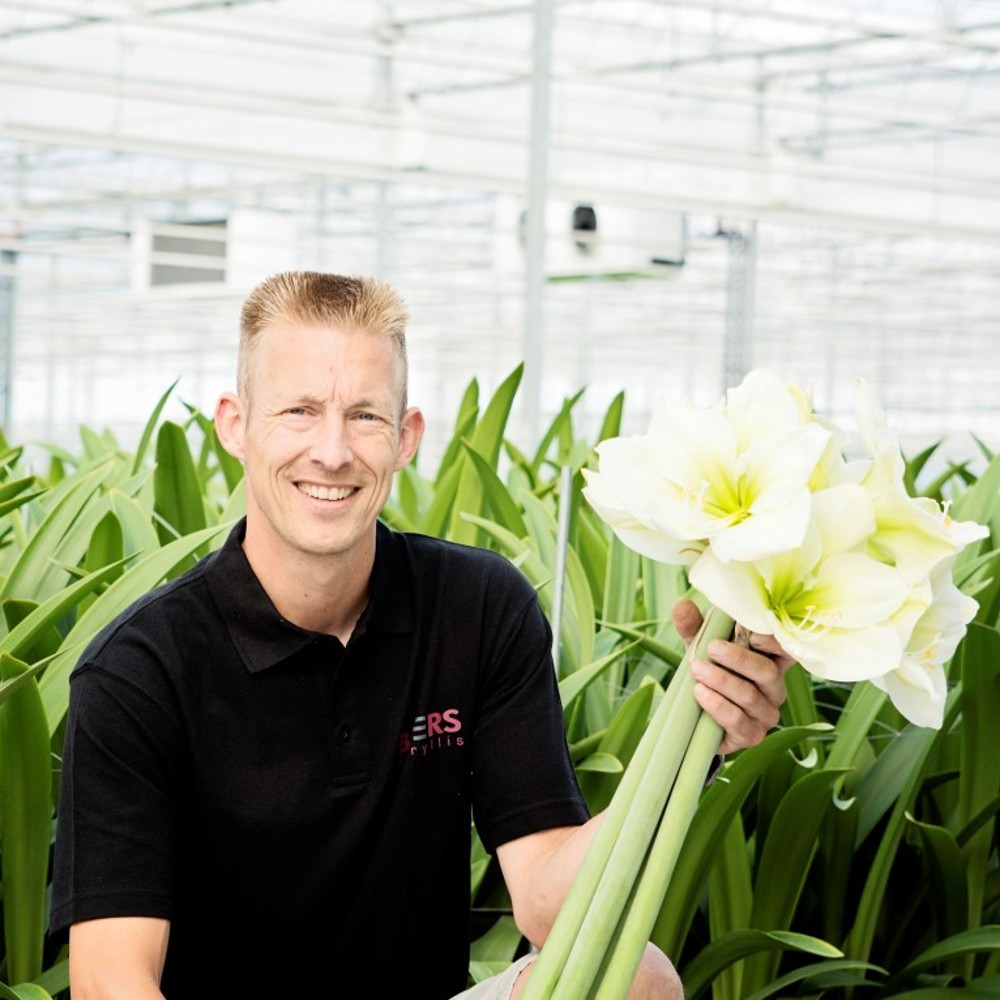Supplementary feeding of predatory mites with pollen yields exceptional results
Amaryllis grower Erik Boers wants to keep his crop healthy, preferably using biological crop protection. This year he made a single introduction of predatory mites to control thrips and then developed the population using Nutrimite™. He is enthusiastic about the initial results. Meanwhile the mice, which loved the bran component of his previous control strategy, have been outmanoeuvred.
At Erik Boers’ company, thrips are a regular uninvited guest. Erik grows both amaryllis bulbs and flowers on 6.5 hectares. The bulbs, which are grown in open soil, are sold for dry sales while the flowers, cultivated on clay pellets, are marketed during the winter season.
Erik is a member of the Decorum grower cooperative, which sells a fully sustainable range of flowers and plants. With all members Global- or MPS-Gap-certified at the minimum, biological crop protection fits well with the cooperative’s profile.
Closed leaf bud
Fighting disease in Amaryllis is not simple. After the flowers are harvested, the leaves appear. However, the leaf buds are initially so tightly closed that it is difficult to effectively spray them, let alone comprehensively scout for pests and beneficial insects.
“These challenges are further compounded by the fact the crop remains in the ground for three years,” explains Erik. “After harvesting the soil is steamed, parcel by parcel, so we are never able to clean the greenhouse completely – or apply optimum hygiene measures.”
Working with a Biobest competitor, three years ago Erik’s first attempted to control thrips using Amblyseius swirskii and introduced cultivation sachets several times. The sachets were filled with predatory mites, bran and factitious prey. “What we hadn’t counted on were the mice,” says Erik. “During the summer months they were attracted by the smell of the bran – I even saw them running around with sachets in their mouths! It was not a satisfactory solution, to say the least.”
Offering food
This year Eric decided to try a different biological pest control strategy in a newly replanted section of the glasshouse. He chose the Biobest strategy – featuring a combination of Swirskii-Breeding-System and Nutrimite™ – a system avoiding the need to continually reintroduce sachets. Crop Protection Specialist, Marvin Koot, advised Eric to introduce Swirskii-Breeding-System just once in early spring to develop a population of predatory mites for the entire cultivation year.
“Immediately after the flower harvest, there were insufficient thrips in the greenhouse to sustain the predatory mites,” says Marvin. “It was therefore necessary to provide the mites with sufficient food to sustain them. Our feed supplement Nutrimite™, based on specially selected pollen, has proved ideal.”
Since introducing the predatory mites, every fourteen days the team has manually blown in the pollen.
“You can barely see it, but it does work,” says Erik. “In fact, it worked exceptionally well.”
Later on during the growing period, just to be sure, he introduced some loose predatory mites in one variety. While occasionally he still sees a few thrips, the pest is now well under control. “When it comes to thrips control, this ‘test’ has been a success,” says Erik. “Although it would be helpful to automate the dispersion process to simplify application.”
Cooling period
Prior to flowering, the crop is cooled and the leaves removed. At this point, both the thrips and predatory mites disappear. In theory, the predatory mites could survive this period, as they can tolerate temperatures as low as 13°C. However, before the start of flowering, growers traditionally spray against other pests which means new predatory mites need to be introduced in spring.
“As things stand, you can’t rely solely on biological crop protection,” explains Erik. “You have to occasionally take action against mealybug, narcissus mite, cicadas and caterpillars – however, we are tending more and more to go biological.”
Unique combination
Eric chose Biobest as its partner because of the unique combination of predatory mites and supplementation with pollen – a combination other suppliers do not offer. Supplementation with factitious prey does not appeal to him, because the carrier falls into the heart of the plant and bulb and can rot.
Erik is also pleased with the advice he receives from Biobest with Marvin paying regular visits every fourteen days to discuss and adjust the strategy as necessary.
“We are seeing growing interest in this strategy,” says Marvin. “This year we have added several new customers growing Amaryllis.”
Decorum (https://www.decorumplantsflowers.com/)



